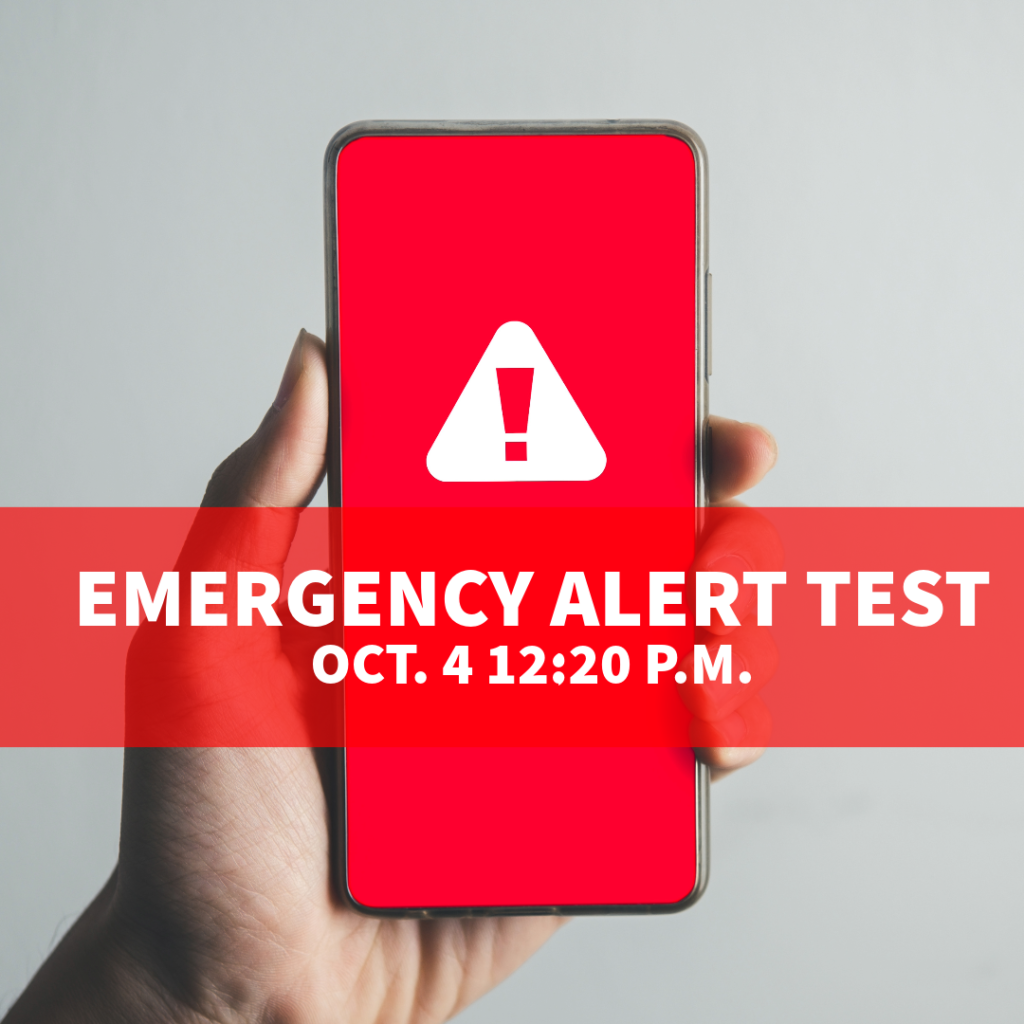Imagine this scenario: you’re going about your day, and your telephone emits a noisy, startling sound accompanied by a message that announces, ‘THIS IS A TEST of the National Wireless Emergency Alert System. No motion is wanted.’ While it may be alarming, relaxation assured, it’s now not an actual emergency. It’s a test! In this blog, we’ll delve into the information of the Emergency Alert Test, what its method is for you, and why it is an important part of keeping you safe.
What is the Emergency Alert Test?
The Emergency Alert Test, also referred to as the National Wireless Emergency Alert System Test, is a national exercise carried out using the United States Federal Communications Commission (FCC) and the Federal Emergency Management Agency (FEMA). The motive of this test is to evaluate and make sure of the effectiveness of the emergency alert system that can be activated within the occasion of a national crisis, such as herbal failures, acts of terrorism, or different sizable emergencies.
Why is the Emergency Alert Test Important?
Ensuring Public Safety
The primary objective of the Emergency Alert Test is to make certain that the public can obtain timely and correct emergency indicators via their mobile phones, radios, and televisions. These signals can offer crucial statistics approximately coming near risks, evacuation orders, and instructions for staying secure.
Testing Technology
With improvements in generation, it’s critical to test the compatibility and reliability of the emergency alert system throughout various gadgets and networks. The test enables us to perceive any capability problems that could arise for the duration of an actual emergency.
Raising Awareness
Participating in the test increases the cognizance of some of the public approximately the existence and importance of the emergency alert system. It reminds people to be organized for emergencies and informs them of the resources to be had to stay knowledgeable.
How Does the Emergency Alert System Work?
The Emergency Alert System (EAS) is a complete community designed to disseminate emergency messages to the general public. It is predicated on various channels, which include:
Cellular Networks
Mobile phones get hold of Wireless Emergency Alerts (WEAs), which are brief emergency messages dispatched through the legal government. These signals are place-primarily based, ensuring that the simplest humans in the affected area acquire them.
Television
EAS messages are broadcast on television channels, interrupting everyday programming to deliver important facts.
Radio
Radio stations participate in the EAS, broadcasting emergency messages to their listeners.
NOAA Weather Radio
The National Oceanic and Atmospheric Administration (NOAA) operates a community of weather radio stations that can broadcast emergency alerts related to severe climate occasions.
When and Where Will the Test Happen?
The upcoming Emergency Alert Test is scheduled for Wednesday, October 4th, at about 2:20 p.m. Eastern Time (ET) and eleven:20 a.m. Pacific Time (PT). It’s critical to be aware of your local time region to ensure you get hold of the test alert at the perfect time.
The check can be performed nationwide, meaning it will cover the entire United States. If your phone is inside the range of a cell tower, you may obtain the test message.
What to Expect During the Test
When the Emergency Alert Test starts, you can anticipate the subsequent:
- Your cell phone will emit a noisy sound to get your attention.
- A message will appear on your phone’s screen, indicating that it is a test of the National Wireless Emergency Alert System and that no action is needed.
- If you are watching TV or taking notes on the radio, the ordinary programming might be interrupted, and you will hear or see the emergency check message.
It’s essential to not forget that this is the simplest a take a look at, and there’s no purpose for alarm. However, it is an extremely good possibility to get yourself up to speed with how the machine works and what to anticipate in the event of a real emergency.
Additional Tips:
- Stay Informed: Sign up for emergency signals and notifications via nearby government and apps like FEMA’s reliable app, Wireless Emergency Alerts (WEA), and the Emergency Alert System (EAS). These will offer you real-time information for the duration of emergencies.
- Emergency Kit: Prepare an emergency package with crucial supplies which include non-perishable meals, water, a flashlight, batteries, a first-useful resource package, and essential files. This kit will be accessible in the course of real emergencies.
- Family Communication Plan: Develop a circle of relatives communique plan that includes touch facts, meeting places, and a chosen out-of-city contact individual. This will help your circle of relatives stay connected in case you’re separated at some stage in an emergency.
- Know Your Surroundings: Familiarize yourself with your neighborhood region, together with evacuation routes, emergency shelters, and network assets. Being aware of your surroundings may be valuable at some stage in a crisis.
- Stay Calm: During the Emergency Alert Test and in actual emergencies, it is vital to stay calm. Panic can lead to terrible decision-making. Take a deep breath and follow the commands furnished.
- Teach Your Children: If you’ve got children, teach them approximately the emergency alert gadget and what to do after they obtain an alert. Make sure they understand the way to contact you and where to head for help if needed.
Resources:
- FEMA (Federal Emergency Management Agency): Visit the reputable FEMA website for a wealth of resources on emergency preparedness, consisting of publications, checklists, and records about the Emergency Alert System.
- Ready.gov: Ready.gov is any other valuable aid for emergency preparedness. It offers a wide variety of data and equipment that will help you prepare for various kinds of emergencies.
- Local Emergency Management Agencies: Reach out to your neighborhood emergency management organization or workplace to learn about unique emergency plans and resources available in your community. They can provide you with records tailor-made to your location.
- NOAA Weather Radio: Consider getting a NOAA Weather Radio with Specific Area Message Encoding (SAME) technology. These radios can provide weather indicators and other emergency facts unique to your place.
- Red Cross: The American Red Cross gives sources on disaster preparedness, consisting of first-aid and CPR schooling.
- Community Apps: Many neighborhood groups have apps that provide emergency data, such as evacuation routes, haven places, and real-time updates during crises. Check-in case your vicinity has one and download it.
- Wireless Emergency Alerts (WEA): Learn more approximately WEA, the machine that grants emergency alerts to cellular telephones, on the FCC’s website.
Conclusion
One thing important to note about them is that they are essential every time one finds themselves in an urgent situation or an immediate need of an emergency alert. Your participation in this Test contributes to the success of the Nation-wide Emergency Alert System thereby making you feel safer about yourself and your community.
As we are reminded it is on Oct 4th when you see the test message on your phone, TV, or radio, it comes with a loud noise you have to bear in mind it’s just an exercise. Only a test – a signal to our ability to quickly react to emergencies. Keep yourself informed; stay safe and prepared for the actual emergency.
To obtain additional information and updates on the Emergency Alert Test, refer to the websites of the FCC and FEMA. Your safety is our priority.
FAQs:
Q1: Why Emergency Alert Test?
A1: The Emergency Alert Test is designed to evaluate the emergency alert system that would be initiated during a national crisis, for example when there is the threat of natural disasters or acts of terrorism of any kind. This assists in ensuring that the general public can have prompt and true emergency alerts via mobile phones, radios, and TVs.
Q2: What is the schedule for the Emergency Alert Test?
A2: Notice of Upcoming Emergency Alert Test on Wednesday, October 4, 2023, at about 2:20 PM Eastern Time and 11:20 AM Pacific Time. Nationally, throughout the entire country of the USA. You will get the test message if the cell tower is close enough to your phone.
Q3: During the Emergency Alert Test, what should I do?
A3: You do not have to do anything for the test. The mobile phone will produce a loud buzz tone followed by the text ‘This is a Test of the National Wireless Emergency Alert System.No Action. ’will appear on your phone’s screen. During your television viewing or listening to the radio; the emergency test message will interrupt the regular program.
Q4: Is it possible for me not to receive any alerts?
A4: You can only customize different kinds of alerts in the phone’s settings but not the ones concerning the presidential alerts. It is nonetheless reasonable not to turn off emergency alerts on your phone as this enables you to receive important critical information in cases of emergencies.
Q5: However, what if I do not get a text message on my phone in the Emergency Alert Test?
A5: If you do not get the text message on your phone, it would be wiser for you to confirm whether there is an alert sent by your phone. If they are and you have not received a text message by now please contact your mobile service provider, for assistance. Make sure your device can receive a Wireless Emergency Alert.
Q6: What is the Purpose of an Emergency Alert Test and how does it affect devices other than Mobile Phones?
A6: The test involves transmission of the Emergency Alert Test through different channels such as mobile phones, TV, radio, and NOAA Weather Radio. The system uses various platforms to reach the majority of the potential victims.
Q7: What is the distinction between the Emergency Alert Test and a real emergency alert?
A7: The Emergency Alert Test is a scheduled national workout to check the capability of the emergency alert gadget. It is not a real emergency. In evaluation, an actual emergency alert is issued in reaction to an actual emergency or threat, together with excessive weather, a herbal catastrophe, or a safety incident. During an actual emergency, the data provided inside the alert is critical and should be followed as directed.
Q8: Are there any resources to help me prepare for emergencies and live informed?
A8: Yes, there are numerous sources to help you put together for emergencies and live knowledgeable. You can go to websites along with FEMA and Ready.gov for courses, checklists, and facts on emergency preparedness. Additionally, nearby emergency control businesses often offer precise facts for your region. Consider downloading network apps that offer real-time updates and signals for the duration of crises.
Read More: Weka Tool: The Ultimate Tool for Streamlining Your Workflow







